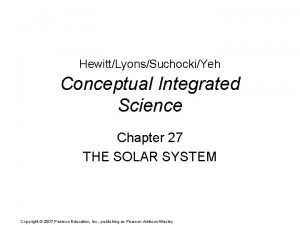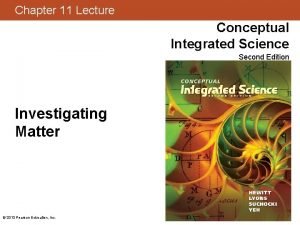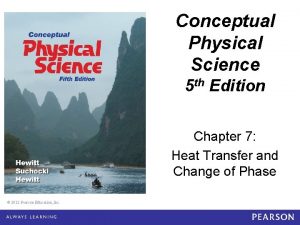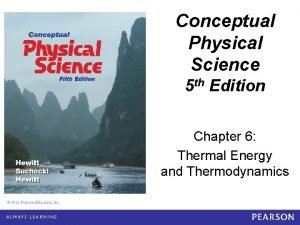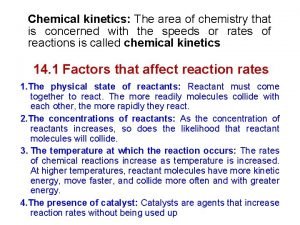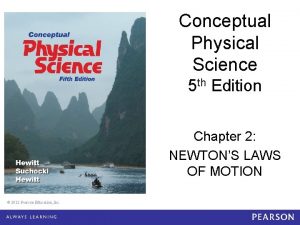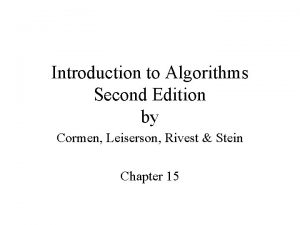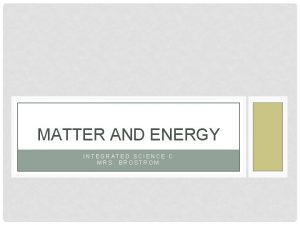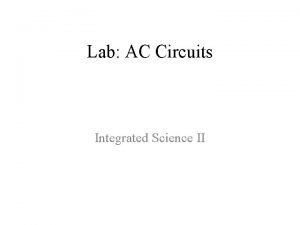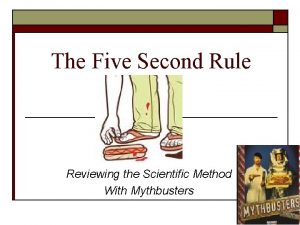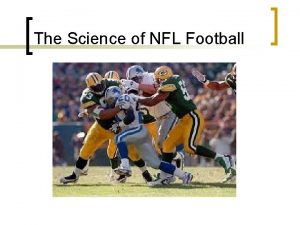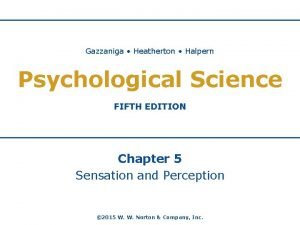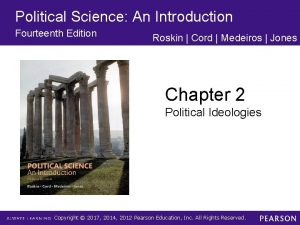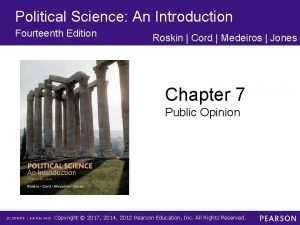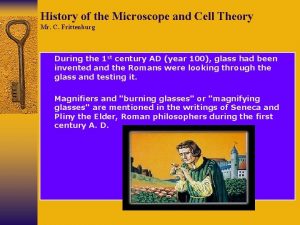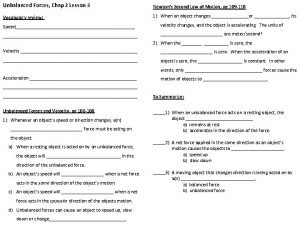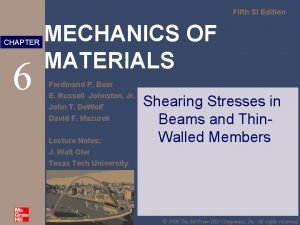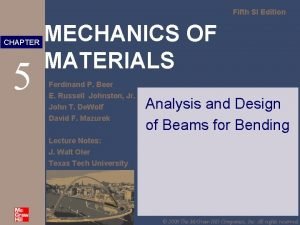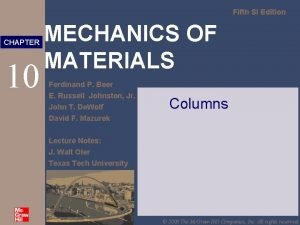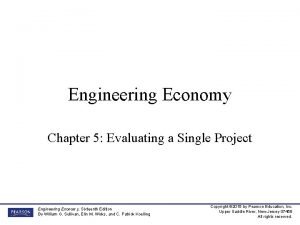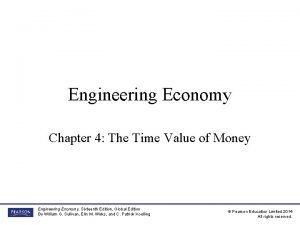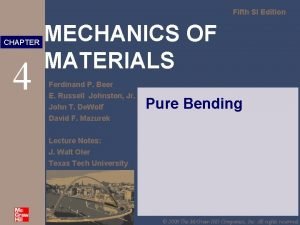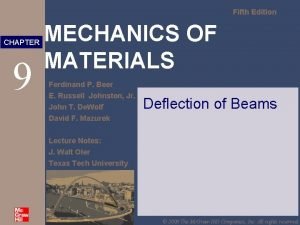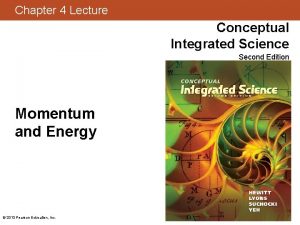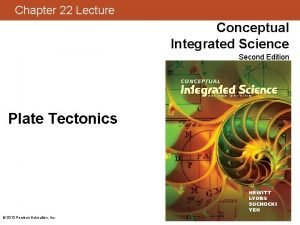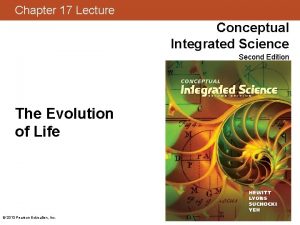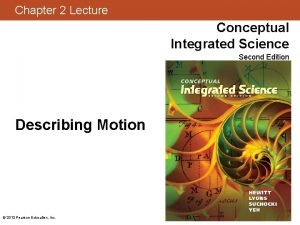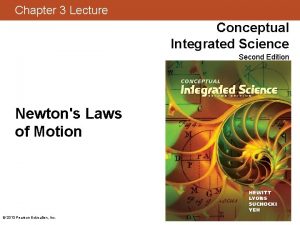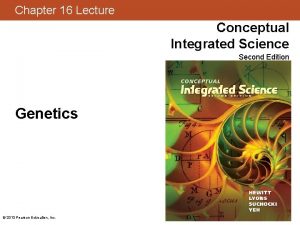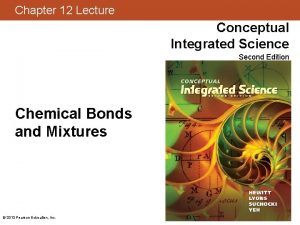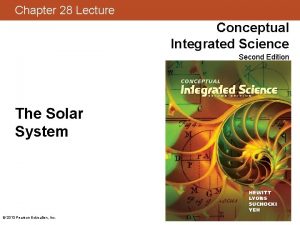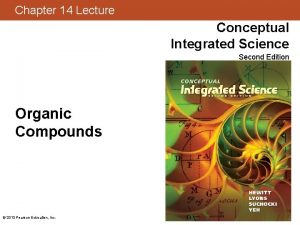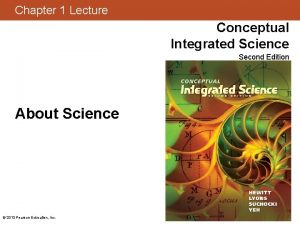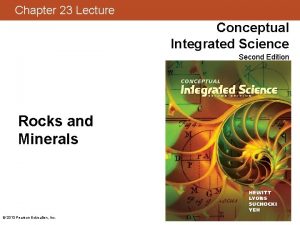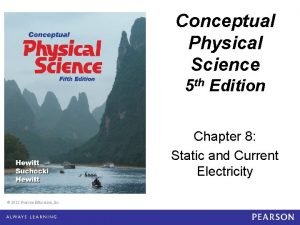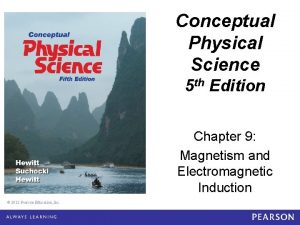Chapter 26 Lecture Conceptual Integrated Science Second Edition



































































- Slides: 67

Chapter 26 Lecture Conceptual Integrated Science Second Edition Weather © 2013 Pearson Education, Inc.

This lecture will help you understand: • • • The elements of weather The greenhouse effect How Earth is warmed from above and below Solar radiation and Earth's seasons Structure and composition of the atmosphere Why air is more dense at sea level than at higher elevations • Why the winds blow • Ocean currents and their influences • Cyclones © 2013 Pearson Education, Inc.

Weather and Climate • Weather is the state of the atmosphere at a particular time and place. • Climate is the general pattern of weather that occurs in a region over a period of years. • Weather is short term; climate is long term. © 2013 Pearson Education, Inc.

Weather and Climate • The six weather elements are: – Atmospheric pressure – Temperature – Wind – Precipitation – Cloudiness – Humidity © 2013 Pearson Education, Inc.

Atmospheric Pressure • Atmospheric pressure is the force the atmosphere exerts on an area of surface. – The force on a surface is the weight of the air molecules above that surface. – At any level in the atmosphere, the force is the total weight of the air above that level. – At higher elevations, there are fewer air molecules above, so the atmospheric pressure is lower. © 2013 Pearson Education, Inc.

Atmospheric Pressure © 2013 Pearson Education, Inc.

Solar Radiation CHECK YOUR NEIGHBOR The atmospheric pressure is highest near the Earth's surface because A. B. C. D. of the weight of all the air above. 90% of Earth's atmosphere is in the troposphere. of warmer temperatures. of water vapor. Explain your answer to your neighbor. © 2013 Pearson Education, Inc.

Structure of Atmosphere • Earth's atmosphere is divided into layers, each with different characteristics: – Troposphere – Stratosphere – Mesosphere – Thermosphere – Ionosphere – Exosphere © 2013 Pearson Education, Inc.

Structure of Atmosphere Troposphere • The troposphere is the lowest and thinnest layer. – 16 km at the equator, 8 km at the poles • In contains 90% of the atmosphere's mass. • Weather occurs in the troposphere because it contains water vapor and clouds. • Temperature decreases with altitude by 6°C per kilometer. The top of the troposphere averages – 50°C. © 2013 Pearson Education, Inc.

Structure of Atmosphere Stratosphere • The stratosphere extends from the top of the troposphere to 50 km above Earth's surface. • It contains the ozone layer, which absorbs harmful UV radiation. – UV radiation splits O 2 molecules into single O atoms, which collide with O 2 molecules to create ozone, O 3 molecules. • The temperature increases because of ozone absorption of UV radiation. – Ranges from – 50°C at base to 0°C at top © 2013 Pearson Education, Inc.

Structure of Atmosphere Mesosphere • The mesosphere extends from the stratosphere up to an altitude of 80 km. • Temperature decreases with altitude because gases in this layer absorb very little UV radiation. – 0°C at bottom to – 90°C at top © 2013 Pearson Education, Inc.

Structure of Atmosphere Thermosphere • There is no well-defined upper limit to thermosphere. • Temperature increases with altitude – Temperature is related to the average speed of gas molecules—very high speed gives high temperatures. • Very low density of gas molecules means very little heat absorption – Very few air molecules collide with one another, so thermometer reading is low. © 2013 Pearson Education, Inc.

Structure of Atmosphere Ionosphere • The ionosphere is not a true layer. • It is an electrified region within thermosphere and upper mesosphere. • The ionosphere contains a auroras—fiery displays of light near Earth's magnetic poles. Exosphere • The exosphere is the interface between Earth and space. • Beyond 500 km, atoms and molecules can escape to space © 2013 Pearson Education, Inc.

Structure of Atmosphere Ozone may be good or bad • Stratospheric ozone is good ozone. – It facilitated the emergence of life on Earth. – It protects Earth from harmful UV radiation. – Stratospheric ozone depletion is detrimental to life. • Tropospheric ozone is bad ozone. – In the troposphere, ozone is a pollutant. • CFCs generated by humans (pollutant) spread throughout the atmosphere. – In the stratosphere, CFCs react with "good" ozone and destroy it (ozone depletion). © 2013 Pearson Education, Inc.

Composition of the Atmosphere • The atmosphere is a mixture of nitrogen gas (97%), oxygen gas (21%), and trace gases. The atmosphere also contains aerosols (suspended particles). • Important trace gases include the major greenhouse gases: water vapor, methane, and carbon dioxide. Argon, neon, helium, hydrogen, ozone, carbon monoxide, sulfur dioxide, and nitrogen dioxide are other atmospheric trace gases. • Aerosols in the atmosphere include dust, ash, diesel exhaust (soot), water droplets (in clouds of rain), ice crystals, air pollutants, and pollen. © 2013 Pearson Education, Inc.

Solar Radiation CHECK YOUR NEIGHBOR The "ozone hole" is considered to be a problem because ozone A. is a pollutant that creates smog. B. depleted from the stratosphere contributes to an increase of harmful UV rays at Earth's surface. C. is detrimental to life on Earth. D. at the troposphere contributes to skin cancer. Explain your answer to your neighbor. © 2013 Pearson Education, Inc.

Climate and Latitude • The world is divided into different climate zones. Temperatures are – highest in the tropics, near the equator. – lower nearer the poles. – moderate and variable in the temperate zone. © 2013 Pearson Education, Inc.

Solar Radiation • Solar Radiation is emitted by the sun. – It is energy in the form of electromagnetic waves. – The Earth only receives about two-billionths of the total energy released by the Sun. • But that is just about the right amount to sustain life on Earth. © 2013 Pearson Education, Inc.

Solar Radiation • A bit less than half of the radiant energy from the Sun is in the form of visible light. © 2013 Pearson Education, Inc.

Solar Radiation • Solar radiation is electromagnetic energy emitted by the Sun. – Visible, short-wavelength radiation • Terrestrial radiation is solar radiation re-emitted from Earth's surface. – Infrared, longer-wavelength radiation © 2013 Pearson Education, Inc.

Solar Radiation • The Sun warms Earth's ground, and the ground, in turn, warms Earth's atmosphere. – Earth's temperature varies according to the solar intensity—the amount of solar radiation per area. – Where solar intensity is higher, temperatures are higher. © 2013 Pearson Education, Inc.

Solar Radiation • Solar intensity is highest where the Sun's rays strike Earth's surface straight on. • This is like a flashlight beam at a 90° angle to the surface. • Equatorial regions have high solar intensity. • Solar intensity is weaker where the Sun's rays strike Earth's surface at an angle. • This is like a flashlight beam at an angle to the surface. • Higher latitudes have lower solar intensity. © 2013 Pearson Education, Inc.

The Greenhouse Effect • Short-wave radiation from the Sun passes through the atmosphere and is absorbed at Earth's surface. Earth absorbs the short-wave radiation and in turn emits long-wave (infrared) radiation (also called "terrestrial radiation"). The atmosphere is opaque to long-wave radiation because certain atmospheric gases (greenhouse gases) absorb it. The infrared radiation is trapped; that is, it is absorbed and re-emitted many times by atmospheric molecules. This warms the atmosphere and is similar to what happens in a florist's greenhouse. © 2013 Pearson Education, Inc.

Solar Radiation • When the light energy that reaches the ground is absorbed, the ground in turn warms up and emits energy. – This energy is called Terrestrial Radiation • It has less energy and longer wavelengths than solar radiation. © 2013 Pearson Education, Inc.

Solar Radiation • The Earth’s atmosphere is transparent to shortwave visible light, but it does not allow infrared waves to freely pass through. © 2013 Pearson Education, Inc.

© 2013 Pearson Education, Inc.

© 2013 Pearson Education, Inc.

Solar Radiation • As a result of this human caused (anthropogenic) greenhouse effect, the Earth’s average temperature has increased. – This threatens the biosphere – We call it Global Warming or Climate Change. © 2013 Pearson Education, Inc.

Global Climate Change • There have been many different climatic transitions over geologic time. • Today, Earth is experiencing a warming trend— apparently from human activities: "anthropogenic" climate change. • The greenhouse effect is the warming of the atmosphere as terrestrial radiation is trapped by "greenhouse gases. " © 2013 Pearson Education, Inc.

Global Climate Change • Humans have an impact on climate change by: – Burning of fossil fuels – Deforestation • Both produce an increase in greenhouse gases. • Scientists agree that Earth is warming. The effects of that warming are still being investigated. Some effects can be predicted with more certainty than others. © 2013 Pearson Education, Inc.

The Seasons • Variation in solar intensity with latitude and the tilt of the Earth's axis helps to explain the different seasons. © 2013 Pearson Education, Inc.

The Seasons • When the Sun's rays are closest to perpendicular at any spot on the Earth, that region's season is summer. • Six months later, as the rays fall upon the same region more obliquely, the season is winter. • In between are the seasons fall and spring. © 2013 Pearson Education, Inc.

Solar Time • Earth's revolution (orbit) around the Sun determines the length of a year (365 days). • Earth's rotation on its axis determines the length of a day (24 hours). • The number of daylight hours varies during the year depending on latitude. © 2013 Pearson Education, Inc.

Solar Time • At the summer solstice (June 21), locations north of the Arctic Circle in the Northern Hemisphere have ~24 hours of daylight. • At the winter solstice (December 22), locations north of the Arctic Circle have ~24 hours of night. • In the Southern Hemisphere, the situation is reversed in locations south of the Antarctic Circle, (summer solstice is in December). © 2013 Pearson Education, Inc.

Solar Time • Halfway between the summer and winter solstices are the equinoxes. – Equinox in Latin means "equal nights. " – Mid-September is the autumnal (fall) equinox. – Mid-March is the vernal (spring) equinox. • The equal hours of day and night are not restricted to high latitudes but occur all over the world. © 2013 Pearson Education, Inc.

Solar Radiation CHECK YOUR NEIGHBOR On the fourth of July in Kansas City, Missouri, the season is _____. On the fourth of July in Perth, Australia, the season is ______. A. B. C. D. winter; spring summer; fall summer; winter; summer Explain your answer to your neighbor. © 2013 Pearson Education, Inc.

Solar Radiation CHECK YOUR NEIGHBOR The days are generally longer during the summer than during the winter. How can the number of daylight hours during the summer be about the same in both the Northern and the Southern Hemispheres? A. B. C. D. They aren't the same. The seasons are the same, but the time of year the season occurs is different. Daylight hours are the same worldwide during the summer. Daylight hours vary with latitude. Explain your answer to your neighbor. © 2013 Pearson Education, Inc.

Wind: Circulation of the Atmosphere • Wind is air that flows horizontally from higher pressure to lower pressure—that is, across a pressure gradient. • The greater the pressure gradient, the stronger the wind. • Winds are named according to the direction from which they blow; "westerly" winds blow from the west. © 2013 Pearson Education, Inc.

Wind: Circulation of the Atmosphere • Air pressure differences are caused by uneven heating of the Earth's surface. • Local differences in heating contribute to smallscale local winds. • Planet-scale differences occur because of variations in solar intensity. Equatorial regions have greater solar intensity than polar regions. – Differences contribute to global wind patterns. Global winds are also called "prevailing winds. " © 2013 Pearson Education, Inc.

Wind: Circulation of the Atmosphere • Warm air characteristics: – Warm air expands. – Warm air rises. – Warm air has lower density and (generally) lower pressure. • Cool air characteristics: – Cool air contracts. – Cool air sinks. – Cool air has higher density and (generally) higher pressure. • Movement of warm and cool air occurs in convection cycles in the lower atmosphere. Air is warmed at Earth's surface, rises, cools, and then sinks to be warmed near the surface again. © 2013 Pearson Education, Inc.

Wind: Circulation of the Atmosphere • Local winds: – Not all surfaces are heated equally. • Example: Land heats and cools more rapidly than water. – Unequal heating results in pressure differences. And pressure differences result in wind. • Remember: Wind is air that flows horizontally from higher pressure to lower pressure. © 2013 Pearson Education, Inc.

Solar Radiation CHECK YOUR NEIGHBOR More energy is required to raise the temperature of water than the temperature of land. Once heated, water retains the heat longer than land. This concept is related to A. B. C. D. expansion of warm air. pressure differences of land water's high specific heat capacity. expansion of seawater. Explain your answer to your neighbor. © 2013 Pearson Education, Inc.

Solar Radiation CHECK YOUR NEIGHBOR At a schoolyard there is a blacktop area and a grassy area. On a particularly warm day, a small breeze develops. Air moves from A. B. C. D. the grassy area to the blacktop to the grassy area. low pressure to high pressure. There is not enough information. Explain your answer to your neighbor. © 2013 Pearson Education, Inc.

Circulation of the Atmosphere Global or prevailing winds • High solar intensity at equatorial latitudes generates powerful, worldwide convection cells —heat redistribution. • Convection cells that move heat from the equator to the poles are called Hadley cells. – Named for George Hadley, an 18 th-century English lawyer and amateur meteorologist © 2013 Pearson Education, Inc.

Circulation of the Atmosphere • At the equator, there is a zone of rising warm, moist air and low pressure. – This area is called the doldrums. – There are trade winds at 0°– 30°. • At 30° N and S latitude, dry air cools and sinks and the pressure is high – This area is called the horse latitudes. – Many of the world's deserts are here. – The winds are westerlies (30°– 60°). • At 60° N and S latitude, cool, dry air meets warm, moist air and the pressure is low. – This area is called the polar front. – The wind are polar easterlies (60°– 90°). © 2013 Pearson Education, Inc.

Circulation of the Atmosphere © 2013 Pearson Education, Inc.

Circulation of the Atmosphere • Earth's rotation greatly affects the path of moving air. – Coriolis effect: Moving bodies (such as air) deflect to the right in the Northern Hemisphere, to the left in the Southern Hemisphere. – Deflection of wind varies according to speed and latitude. • The faster the wind, the greater the deflection. • The deflection is greatest at the poles and decreases to zero at the equator. © 2013 Pearson Education, Inc.

Solar Radiation CHECK YOUR NEIGHBOR The prevailing westerly winds are affected by the Coriolis effect by the deflection of winds A. to the right in the Northern Hemisphere and to the left in the Southern Hemisphere. B. to the left in the Northern Hemisphere and to the right in the Southern Hemisphere. C. laterally toward the poles. D. westward. Explain the answer to your neighbor. © 2013 Pearson Education, Inc.

Solar Radiation CHECK YOUR NEIGHBOR The prevailing winds in North America are westerly—they blow from west to east. Westerly winds contribute to cooling the western coast A. B. C. D. in the winter and warming it in the summer and warming it in the winter. so that the temperature is the same all year long. and making temperature variations more extreme. Explain your answer to your neighbor. © 2013 Pearson Education, Inc.

Circulation of the Atmosphere Factors that affect wind: • The pressure gradient force: Air moves from high pressure to low pressure. • The Coriolis effect: There is an apparent deflection of winds due to Earth's rotation. • Frictional force: Air moving close to the ground encounters friction. – Surface friction reduces wind speed, which reduces the Coriolis effect. © 2013 Pearson Education, Inc.

Oceanic Circulation: Currents • Ocean currents are streams of water that move relative to the larger ocean. • Surface currents are created by wind. • Surface ocean currents correspond to the directions of the prevailing winds. © 2013 Pearson Education, Inc.

Oceanic Circulation: Currents Factors that influence ocean currents: • For short distances, wind is the strongest factor. • For longer distances, the Coriolis effect comes into play. – The Coriolis effect causes surface currents to turn and twist into semicircular whirls called gyres. – Northern Hemisphere gyres rotate clockwise. – Southern Hemisphere gyres rotate counterclockwise. © 2013 Pearson Education, Inc.

Oceanic Circulation: Currents • Surface currents redistribute Earth's heat. • The Gulf Stream current carries vast quantities of warm tropical water to higher latitudes. – Great Britain and Norway have warmer winter temperatures (for their latitude) because of the Gulf Stream. © 2013 Pearson Education, Inc.

Humidity • Humidity is the mass of water vapor a given volume of air contains. • Relative humidity is the ratio: © 2013 Pearson Education, Inc.

Humidity • Air that contains as much water vapor as it possibly can is saturated. – Warm air holds more water vapor than cold air. – As air cools, it holds less and less water vapor. • Saturation can occur when the air temperature drops, causing water vapor to condense. • Saturation and condensation are more likely to occur in cold air because the molecules are slower moving. © 2013 Pearson Education, Inc.

Humidity • The dew point is the temperature at which saturation occurs. • Condensation occurs when the dew point is reached. – Water vapor condenses high in the atmosphere and forms clouds. – Water vapor condenses close to the ground to form dew, frost, and/or fog. © 2013 Pearson Education, Inc.

© 2013 Pearson Education, Inc.

• High Clouds – Made almost entirely of ice crystals because it’s so cold and dry at that elevation. • Middle Clouds – Made up of water droplets and when temperature allows ice crystals. • Low Clouds – Most often composed of water droplets, and ice crystals in colder climates © 2013 Pearson Education, Inc.

• Clouds of Vertical Development – Don’t fit into any height categories © 2013 Pearson Education, Inc.

Changing Weather: Air Masses • An air mass is a volume of air that has a characteristic temperature and humidity throughout and tends to remain intact as it travels. • An air mass acquires the temperature and moisture characteristics of its source region. © 2013 Pearson Education, Inc.

Changing Weather: Fronts • A front is the boundary where air masses meet. • When two air masses meet, differences in temperature, moisture, and pressure can cause one air mass to ride over the other. This is frontal lifting. • Fronts are associated with rapid changes in weather. © 2013 Pearson Education, Inc.

Changing Weather: Cyclones and Anticyclones • A cyclone is an area of low pressure around which winds flow. • Due to the Coriolis effect, winds in a cyclone move – counterclockwise in the Northern Hemisphere. – clockwise in the Southern Hemisphere. • Air converges in the center (lowest pressure) and is forced to rise upward. © 2013 Pearson Education, Inc.

Changing Weather: Cyclones and Anticyclones • An anticyclone is an area of high pressure around which winds flow. • Due to the Coriolis effect, the winds in a cyclone move – clockwise in the Northern Hemisphere. – counterclockwise in the Southern Hemisphere. • Air moves downward and outward from an anticyclone. © 2013 Pearson Education, Inc.

Storms • Storms are defined as violent and rapid changes in the weather. • Three major types of severe storms: – Thunderstorms – Tornadoes – Hurricanes © 2013 Pearson Education, Inc.

Storms • Thunderstorms begin with humid air rising, cooling, and condensing into a single cumulus cloud. • When fed by unstable, moist air, a cumulus cloud grows into a thundercloud. • Thunderstorms contain immense amounts of energy. © 2013 Pearson Education, Inc.

Storms • A tornado is a column of air rotating around a low-pressure core that reaches from a thundercloud to the ground. • A funnel cloud is similar to a tornado, but it does not touch the ground. © 2013 Pearson Education, Inc.

Storms • Hurricanes are the greatest storms on Earth. Their energy comes from latent heat released from condensing water vapor. • Rising warm air creates low pressure near the surface, drawing in more moist air. • Winds rotate around a central low-pressure area —the eye of the storm. • There is a continuous supply of energy from tropical waters. • A hurricane weakens as its fuel is cut off (land fall or cooler water). © 2013 Pearson Education, Inc.
 Conceptual integrated science explorations
Conceptual integrated science explorations Conceptual integrated science
Conceptual integrated science Conceptual physical science 5th edition
Conceptual physical science 5th edition Conceptual physical science 5th edition
Conceptual physical science 5th edition Conceptual physical science 5th edition
Conceptual physical science 5th edition 01:640:244 lecture notes - lecture 15: plat, idah, farad
01:640:244 lecture notes - lecture 15: plat, idah, farad Second order integrated rate law
Second order integrated rate law Second order integrated rate law
Second order integrated rate law My favorite subject is english
My favorite subject is english Primary demand stimulation
Primary demand stimulation Conceptual physical science practice sheet chapter 2
Conceptual physical science practice sheet chapter 2 186 282 miles per second into meters per second
186 282 miles per second into meters per second Advanced word power second edition answers
Advanced word power second edition answers Accounting principles second canadian edition
Accounting principles second canadian edition Accounting principles second canadian edition
Accounting principles second canadian edition Accounting principles second canadian edition
Accounting principles second canadian edition Clear thinking and writing second edition answer key
Clear thinking and writing second edition answer key Accounting principles second canadian edition
Accounting principles second canadian edition Kaufman tamine
Kaufman tamine Introduction to algorithms 2nd edition
Introduction to algorithms 2nd edition In company second edition
In company second edition Wechsler individual achievement test second edition
Wechsler individual achievement test second edition Ten steps to advanced reading 2nd edition answers
Ten steps to advanced reading 2nd edition answers Organic chemistry second edition david klein
Organic chemistry second edition david klein Using mis 10th edition
Using mis 10th edition Mis
Mis Second level of conceptual framework
Second level of conceptual framework Physical science lecture notes
Physical science lecture notes What is matter in integrated science
What is matter in integrated science Lone star college nursing program cost
Lone star college nursing program cost Investigating conductors lab report
Investigating conductors lab report Maryland integrated science assessment
Maryland integrated science assessment Mythbusters 5 second rule
Mythbusters 5 second rule Newton's second law of motion - science of nfl football
Newton's second law of motion - science of nfl football Chemistry central science 14th edition
Chemistry central science 14th edition Biological science 6th edition
Biological science 6th edition Rotating snake illusion
Rotating snake illusion The fundamentals of political science research 2nd edition
The fundamentals of political science research 2nd edition Political science 14th edition
Political science 14th edition Political science 14th edition
Political science 14th edition Science power 9 atlantic edition
Science power 9 atlantic edition What is conceptual framework of science education
What is conceptual framework of science education Human resource management 15th edition
Human resource management 15th edition Human resources introduction
Human resources introduction Human resource management lecture chapter 1
Human resource management lecture chapter 1 The second new deal takes hold
The second new deal takes hold Second great awakening apush chapter 15
Second great awakening apush chapter 15 Chapter 2 lesson 3 newton's second law
Chapter 2 lesson 3 newton's second law Organizational behavior 18th edition
Organizational behavior 18th edition Organic chemistry (3rd) edition chapter 1 problem 16s
Organic chemistry (3rd) edition chapter 1 problem 16s Mechanics of materials chapter 10 solutions
Mechanics of materials chapter 10 solutions Mechanics of materials chapter 7
Mechanics of materials chapter 7 Mechanics
Mechanics Beer johnston
Beer johnston Beer and johnson
Beer and johnson Everything's an argument chapter 1
Everything's an argument chapter 1 Chapter 6 portable fire extinguishers
Chapter 6 portable fire extinguishers Engineering economy 16th edition chapter 5 solutions
Engineering economy 16th edition chapter 5 solutions Deffered annuity
Deffered annuity Business essentials 12th edition chapter 1
Business essentials 12th edition chapter 1 Lazarus's appraisal theory
Lazarus's appraisal theory Prehospital emergency care 11th edition
Prehospital emergency care 11th edition Role requirements change in different situations
Role requirements change in different situations Organic chemistry (3rd) edition chapter 1 problem 20s
Organic chemistry (3rd) edition chapter 1 problem 20s Landmark in humanities 5th edition
Landmark in humanities 5th edition Discontinuous development psychology
Discontinuous development psychology Mechanic of materials
Mechanic of materials Ferdinand beer
Ferdinand beer
